Most readers will concur that there is often certain important gear on boats that receives little attention, that is, until its needed. The storm trysail, emergency tiller, and life raft come immediately to mind. The onboard medical kit usually fits into this category as well. Its stowed away somewhere safe and given little thought, but it becomes indispensable when the need arises.
When you consider that we sailors select critical gear like ground tackle based on a set of criteria-the boats length, displacement, windage, and the areas in which we anchor-its only fitting that medical kits be chosen by way of similarly appropriate criteria as well. Essentially, they should contain supplies and medications commensurate with the crew on board, the captains sailing style, the waters in which he or she is sailing, and the length of time the vessel will be away from professional medical assistance.
Photo by Ericsson Racing Team
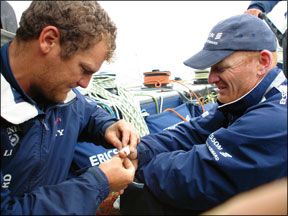
Beginning with this issue, Practical Sailor will offer a series of articles this year that will evaluate a variety of on-board medical kits. Our initial assessment focuses on kits intended for use in near-shore and inshore daysailing situations where medical help is always within easy reach. We obtained four such products that range in price from $45 to $575. This initial collection weve labeled Group I.
Due to the assumption that medical assistance is readily available when these kits are used, early stabilization of a wound or a trauma victim is the primary objective here. These kits should provide sufficient equipment and medicine so that those who use them can stabilize the situation until professional help arrives. Nonetheless, it is paramount that anyone on the water be fully competent in CPR and first aid, and have the knowledge to attend to a seriously injured patient until help arrives. That leads us to an important caution: Its critical that sailors strive to increase their medical knowledge and skills when anticipating longer passages or extended periods away from medical assistance. Having kits brimming with supplies on board does little good when nobody on the boat knows how to use them.
Basic Emergencies
When using Group I kits, the medical concerns will primarily range from minor cuts to more severe lacerations and abrasions, bruises, and sprains. The relative instability of vessels on the water, coupled with the variety of activities that might occur afloat, can always lead to other misfortunes. Examples here include sunburn, seasickness, head trauma, fractures, near-drowning, hypothermia, burns of various types, and disorders related to overheating. Still, when professional assistance is nearby, its not necessary for Group I kits to contain supplies beyond basic first-aid needs.
What is necessary is that the materials in a medical kit be well organized. Most manufacturers of these kits segment the contents into modules that are organized by the kind of care needed. We endorse this approach. The accompanying list (see page 31) represents the minimum standards against which Practical Sailor rated the Group I kits. Certainly, a kit with additional supplies or medications would be more beneficial, and some manufacturers do offer optional contents. Additional items could include sunscreen, anti-seasickness medications, antacid tablets, anti-emetics, and a CPR face mask.
Particularly on longer sails, any crewmember with pre-existing medical conditions should bring all prescription medications and notify the skipper of those medications and dosage schedule. Items such as anti-depressants, birth control, antibiotics, and insulin are examples of these medications.
Ocean Medical Crew/Day Kit
Volvo Ocean Race
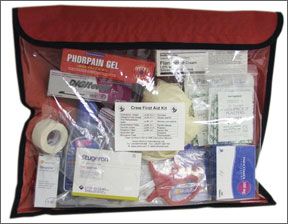
Designed as a first-aid kit for day crew less than an hour from help, this is one of the least-expensive kits available from Ocean Medical International, a company that specializes in providing high-quality medical supplies and services to international yachts. This $575 kit exceeds our price limit for this category, but OMI-which includes prescription medicines in all of its kits-does not offer a comparable kit for less than $100.
The clear vinyl packaging is neither watertight nor shock-resistant, because its designed for placement within a secure locker on larger ships. (A different version of this kit is available in a secure, hard-plastic container.) Additionally, we found the contents to be rather loosely contained and disorganized.
This kit ranked lowest compared to our group standard because it lacked three elements we consider essential. (See Value Guide table, above.) However, it contained prescription medicines beyond our bare minimum requirements.
The OMI kits contain extremely well-written instructions. Further instruction in first aid, CPR, etc. are available. Another nice feature is that the company maintains a medical advice service
-at extra cost-where consultants can be contacted at any time day or night to assist with emergencies via electronic communication. The company also specializes in prescription services.
Bottom Line:
This kit lacks a number of basic items (butterfly bandages and aspirin among them) and has its contents randomly arranged in a less-than-protective pouch. The quality of the medical supplies is very good, but for $575, wed expect far more.
Adventure Medical Marine 250
Specifically designed for vessels sailing an hour or less from medical help, the Adventure Medical Marine 250 boasts an array of medical supplies sufficient for one to four crew members. Like OMI, this company is directed by doctors who are also adventurers. One partner, an expert in survival equipment, runs a foundation dedicated to product testing.
Perhaps thats why the $45 Marine 250 has the most rugged and secure container of those in this category. The thermo-formed case, which closes with a plastic zipper, ranked highest in water integrity, shock resistance, and durability. We found the contents to be high quality and liked that they were arranged in separate, water-resistant modules that kept the kit neat and the items easy to locate. The instructions, which include Dr. Eric Weiss and Dr. Michael Jacobs fine booklet, A Comprehensive Guide to Marine Medicine, are also very complete and easy to follow.
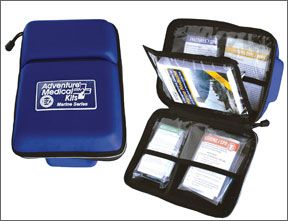
Bottom Line:
Thanks to its superb organization, this kit would be the easiest to use in an emergency. Its also the most complete in contents, with the most robust container, and a very attractive price. Its our Best Choice.
Fieldtex Day Pak
Based in Rochester, N.Y., Fieldtex has been a manufacturer/distributor of medical and first-aid products for 12 years. The company offers an array of medical kits; those created specifically for marine use range in price from $18 to $900.
Practical Sailor evaluated the $99 Day Pak (soft-case version), which is designed for “day-long or overnight trips with up to six persons.” The contents ranked high in quantity and quality. This kit was lacking in only one basic item that was contained in our model medical kit-an elastic adhesive bandage.
Four separate modules, segmented by type of injury, with an additional module for personal medications, kept the contents well organized, making locating specific items easy and fast. However, the contents are more difficult to keep organized because they come in a soft container. (A hard pack adds $50 to the price.)
Practical Sailor testers found the waterproof instruction manual to be very good. Fieldtex uses First Aid by the Numbers. And we liked that the instructions offer a module-by-module inventory of contents.
Due to the soft-fabric container, the Day Pak ranked lowest on water integrity, shock resistance, and durability, but we favor the bright red color, which quickly identifies this as a medical kit.
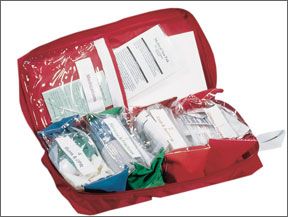
Bottom Line:
The Day Pak has good organization, contents, and instructional materials in a less-than-impressive container. If we had to have this kit, wed likely shell out the additional $50 for the hard-case version.
West Marine 300
Boating retailer West Marine markets nine different marine medical kits that range in price from $30 to $670. We evaluated the more economical West Marine 300, which the company advertises as having up to four days of supplies for up to six people for inshore voyages. (How the injuries are to be rationed out eludes us completely.)
The contents of this kit are segmented into five modules, each dedicated to a different kind of injury or malady. Each module houses its materials in a resealable, waterproof plastic bag.
The kit is contained in an easily identified nylon, zippered bag. For ruggedness and water-resistance, the West Marine 300 ranks in the middle of this group. The case is compact, and it comes with a nearly complete set of contents. (It lacks only butterfly bandages and an elastic adhesive bandage to meet our minimum requirements.)
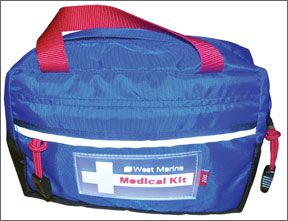
West Marine uses the same manual from Weiss and Jacobs that Adventure Medical uses in its kits.
Bottom Line:
The 300 is a compact, well-organized, and well-equipped kit with good instructions, but wed like to see butterfly bandages included.
Conclusion
All of these kits are suitable for use on boats within mere hours of medical attention, and they all come close to meeting our minimum content requirements. Three of the kits are organized into distinct modules of care, enabling fast and easy access. Modules are generally arranged into items for minor cuts, larger wounds, trauma such as sprains, medications, and supplies (tools such as tweezers, forceps, scissors, etc.). The modules in each kit are labeled and packaged in plastic, water-resistant, see-through pouches. Testers were impressed by the quality of the medical manuals/books in these kits. These materials are as good as those contained only in the most expensive medical kits available a few years ago.
The quality and quantity of the medical supplies in these kits was generally high. The Crew/Day kit from Ocean Medical International lacked the most. Only two kits-the Day Pak from Fieldtex and the Marine 250 from Adventure Medical contained butterfly bandages, which can be necessary in closing a wound that would otherwise require sutures. Butterflies can be made from adhesive tape, but having them supplied is preferable.
Containers ranged from flimsy to very sturdy. In the marine environment, with the likelihood of exposure to moisture and salt, its imperative that the container be sufficiently watertight and tough enough to protect its contents in rough sea conditions. The primary difference between kits that are contained in light plastic fabric and those with more substantial shells is that the supplies in the former can be subjected to exposure, leading eventually to mildew and corrosion. The shock-resistant Adventure Medical kit was clearly the strongest and most impervious to the elements, but the zippers will need to be cleaned and lubricated regularly. A watertight, plastic case (like the Pelican-brand type) would be our preference here.
Except for the lack of eye wash solution, the contents of the Adventure Medical 250 kit met and surpassed our minimum requirements. It gets the nod for Practical Sailor Best Choice. The next best kit was the Fieldtex Day Pak.



































Great article! Being on a boat means being by myself. While that means I’m afforded a certain degree of peace, it also means I am left to my own devices in emergencies, thus the need for the right marine first aid kit.